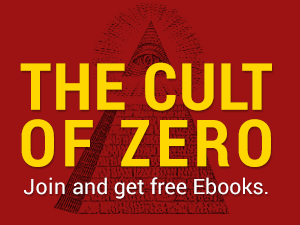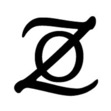Conrad Zero's Blog: Conradzero.com, page 3
June 16, 2015
Dark Fiction Review – A Circus Of Brass And Bone
Full Disclosure: Abra Staffin-Wiebe is a fellow member of the Minnesota Speculative Fiction Writers’ Group, and I made a contribution to her mothers treatment (see below for details) and in return Abra wrote a bit-character appearance of me into the story.
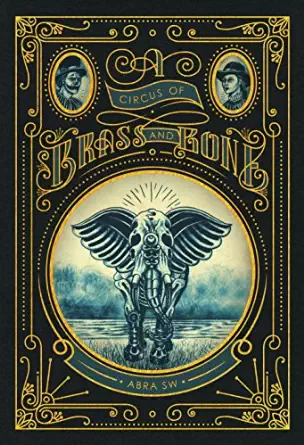 A Circus Of Brass And Bone is the first novel by author Abra Staffin-Wiebe, publishing under Abra SW. The story takes place in post-Civil War America, in a world without electricity. Rather, Fire Aether powers anything that isn’t run by the low tech of steam. This alternate reality is filled with strange and wonderful inventions like Bone aether (for healing wounds), and aether-powered-mechanical war elephants.
A Circus Of Brass And Bone is the first novel by author Abra Staffin-Wiebe, publishing under Abra SW. The story takes place in post-Civil War America, in a world without electricity. Rather, Fire Aether powers anything that isn’t run by the low tech of steam. This alternate reality is filled with strange and wonderful inventions like Bone aether (for healing wounds), and aether-powered-mechanical war elephants.
The Loyale Travelling Circus and Menagerie is at sea when they discover their ringmaster murdered, (by one of their own) which is the least of their problems. An apocalyptic aether storm rolls across the world, and the story begins with Chapter One: Everyone Dies.
When the circus docks in Boston, they discover a third of the population has been wiped out, crops are tainted and most aether technology devices are ruined or unstable at best. People are showing symptoms of exposure to the aether storm and what exactly is making all that noise in the woods?
Crossing a steampunk (aetherpunk?) version of The Stand with Carnivàle, A Circus Of Brass And Bone is a rag-tag exploration and adventure by a cast of colorful circus characters in an alternate reality turned upside-down by calamity and devastation.
“In such desperate times, what use is a circus?”
The Story Behind The Story
It’s strange that the tiny section following the main story in A Circus Of Brass And Bone could be more disturbing than the apocalyptic world-ending tragedy of the story itself. But the story behind the story is much more sad, and unfortunately, true.
Abra’s mother, Cookie, was diagnosed with stage 3c cancer. Over the next year and a half, Abra wrote and released short chapters of the story which would eventually become A Circus Of Brass And Bone. She also recorded and released an audio podcast of the chapters, along with a plea for supporters to help defray Cookie’s medical expenses. Those who helped by contributing toward the writing would be written into the story as guest characters.
Sadly, Cookie passed away fifteen months later. She left behind an essay of reflections and observations which Abra included at the back of the book. Abra dedicates the book to her mother, and I’m sure Cookie is very proud.
Twitter Review
Check out A Circus Of Brass And Bone to fulfill all your post-apocalyptic steampunk adventuring needs! – [TWEET THIS!]
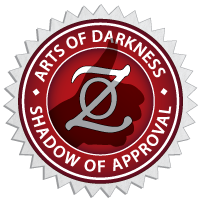 Ubercool Achievement Unlock!
Ubercool Achievement Unlock!A Circus Of Brass And Bone is a great read. ANY book that has an aether-powered-steampunk-war-elephant fighting against a herd of carnivorous-zombie-deer definitely wins the Ubercool tag here.
Her story gets the Arts of Darkness Shadow of Approval award.
More Fiction From Abra SW
Although A Circus of Brass and Bone is Abra’s first full-length novel, it isn’t remotely her first writing. Check out her website below for more high-quality fiction.
Check out this free novelette set in the same world as A Circus Of Brass And Bone: A Stranger Comes To Town
Official Website For A Circus Of Brass And Bone
Facebook Page
A Circus Of Brass And Bone on Amazon
Abra Staffin-Wiebe’s main website: aswiebe.com
More Stories by Abra Staffin-Wiebe
The post Dark Fiction Review – A Circus Of Brass And Bone appeared first on Conrad Zero.
June 5, 2015
Email Security
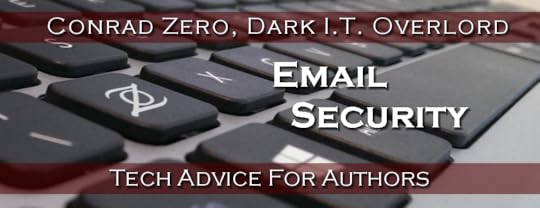 I thought everyone knew that email is NOT a secure method for transferring sensitive information. Apparently not, because at Company X (where, by day, I’m the mild mannered Draconian I.T. Overlord) one of our employees hit the roof when Accounting asked him to verify sensitive account information… via email.
I thought everyone knew that email is NOT a secure method for transferring sensitive information. Apparently not, because at Company X (where, by day, I’m the mild mannered Draconian I.T. Overlord) one of our employees hit the roof when Accounting asked him to verify sensitive account information… via email.
Could be worse – she could have asked him over the building P.A. System.
But honestly, email is not secure. Oh, I know you’re thinking, “But Zero, I’m using https for everything! I run Tor and Disconnect through a proxy service over my neighbor’s wifi! It can’t get any more secure than that, right?”
OK, so maybe you weren’t thinking that. Maybe you weren’t even understanding that. My point is, you can add all the security you like to your computer and your internet connection, but those are just pieces of the whole problem, and small ones at that.
Trouble is, after the mail leaves your email service provider, it bounces all over the bloody interwebs in what can best be described as a worldwide game of Marco Polo crossed with Chutes and Ladders before it arrives at the recipient’s inbox. During that trip, it’s trivial for any waypoint on the internet to snoop on the data en-route (called ‘sniffing’) or even make a copy to take offline and hack at later. There are programs ready-made to do this, so it doesn’t even take programming skills. (The programs are called scripts, and people who use them are called script kiddies, btw…)
So I thought it would be prudent to remind everyone of the postcard analogy:
Emails Are Like Postcards
Digitaltrends.com sums it up this way:
…for the foreseeable future, Internet users cannot expect email to be secure from prying eyes or interception. Period.
http://www.digitaltrends.com/mobile/can-email-ever-be-secure/
And here’s what Wikipedia has to say about it:
Email has to go through potentially untrusted intermediate computers (email servers, ISPs) before reaching it’s destination, and there is no way to tell if it was accessed by an unauthorized entity. This is different from a letter sealed in an envelope, where by close inspection of the envelope, it might be possible to tell if someone opened it. In that sense, an email is much like a postcard whose contents are visible to everyone who handles it.
So the takeaway is: Don’t use standard email to send passwords, ssns, credit card numbers, account numbers, birthdays, mother’s maiden names, or any other info that you wouldn’t yell out loud at the courtyard in the Mall of America.
So how can I send sensitive info?
The answer to this question is encryption, where the email is encoded before it is sent. Sounds good right? If you encrypted the message on a postcard, you wouldn’t care who viewed it in transit. The problem is that the message needs to be decrypted at the receiving end. So it requires either sharing the encryption key with the recipient, or sharing a service which does the encryption/decryption for you. Here are some options:
Paid – Encrypted Email Services
Of course there are folks who will take your money to provide encrypted email services. HP’s SecureMail is an example. At $99 per year, it will allow you to create and send encrypted mail. But both parties need to buy into the secure mail service for it to be effective.
If just the sender has the service, the recipient will just get a notice of the email, similar to the way you receive sensitive info from financial institutions: “Please sign into the secure message server to read an IMPORTANT MESSAGE!” And that would get annoying. Also, they won’t have a copy of the email in their own email system. Furthermore, if someone sends YOU sensitive info via unencrypted email from an unsecure server… postcard. So this is only really useful if both sender and receiver use the same service. Good luck getting your agent, editor and all your beta readers to pay $99 per year for email service.
It should be obvious now why this method isn’t very popular.
If you decide to go with an encrypted mail service, make sure to pick a company you trust. Jimmy’s Kewl Encrypto-Mail Plus sounds like a bargain at only a dollar per month, but do you really trust Jimmy to keep your data safe?
Free – Encrypt Your Own Email
For the “why can’t it be free?” crowd. Open PGP (Pretty Good Privacy) is free and effective, but the setup requires a 4-year degree in computer science and the sacrifice of several virgins. Here’s an article on how to encrypt your own email using PGP.
As techcrunch.com points out, savvy users can try out https://www.mailvelope.com/ which helps make the PGP encryption integration less painful.
Speaking of painful, facebook (spit) now allows you to enter your PGP key for encrypting your facebook (spit) email. So if both the sender and receiver set it up and keep their mail within facebook (spit), it would theoretically allow secure email communication. But I personally wouldn’t trust that company to walk my cat, so good luck with this option. Encrypting your email on facebook (spit)
Password-protected file attachment (Requires Word, Excel, PowerPoint, Adobe Acrobat Std, 7-Zip or other software)
A far easier method is to put the sensitive data into a password-protected file, and attach it to the email. There are many programs that have encryption built-in:
How to encrypt/password protect a pdf document using Adobe Acrobat Standard.
How to encrypt Microsoft Office docs (Word, Excel and PowerPoint)
How to encrypt ANY files using 7-zip
The question is, “are these methods really secure?” The answer is, “Mostly.” At the very least, they are much better than sending the sensitive info in an unencrypted email. Here is a discussion about the security of application-specific encryptions like the ones I’m mentioning here.
What a Pain! Seriously Zero, how can I cheaply and easily send sensitive info across the bleeping planet?
All this mucking about with encryption makes you wonder if your Steampunk Paranormal Romance manuscript is really that sensitive. But we can’t simply hand our data over to script kiddies, mobsters and the NSA. Besides, businesses are chomping at the bit for a simple and effective method of transmitting proprietary and confidential data across the planet. That means there’s money to be made, and that means it’s only a matter of time till someone solves this problem.
The good news is you do still have some options. Here are some methods of data transmission that are more secure than email and easy to use:
Fax – The only unsecure thing about a fax is that you don’t have eyes on where it comes out in the real world. Is it going right into the hands of the recipient, or sitting in the public copy room for a week until the recipient gets back from vacation? This method is best if you coordinate the sending with the recipient. Just be sure the recipient isn’t using some kind of fax-to-email conversion service, or you just wasted your time…
Phone – Although this one is still questionable, phone calls can be tapped, no doubt, and that voice-to-text technology is getting better. That said, it is going to take a bit more work to actually pull off a wiretap of the cellular phone system. That’s beyond the reach of script-kiddies for now, so unless you are making plans to destroy the entire world, or doing something terribly heinous, I’d trust the security of a phone call over an email any day.
Postal (snail mail) – Until the NSA installs X-ray vision in their spy satellites, this is still the simplest, most effective way to communicate secure information.
Hope this helps! Let me know if you can think of other methods.
The post Email Security appeared first on Conrad Zero.
May 13, 2015
New Dark Fiction – The Whisper Jar by Carole Lanham
If you’re looking for a quick, dark, well-writ-read, look no further. My sister in darkness, Carole Lanham (USA Today Bestselling author of The Reading Lessons) is re-releasing her awesome collection of short stories – The Whisper Jar.
The revised version of The Whisper Jar includes creepy pictures and a new cover which out-creepifies the old cover, and that is no small task.
Review of The Whisper Jar
The following is an excerpt from my original review:
The Whisper Jar blends dark and sometimes paranormal situations into the really-real everyday world with clever writing, an Edgar Allen Poe sensibility, and a splash of Neil Gaiman’s Fragile Things. Carole Lanham writes in her own carefree but intuitive voice. Audiences will slip into these short stories as easily as they would a warm bath, only to be surprised at how quickly the waters deepen. Those looking for a variety of dark character studies, whimsical situations and disturbing relationship dynamics will enjoy The Whisper Jar.
Check out the full review here: Dark Fiction Review: The Whisper Jar by Carole Lanham
The Whisper Jar on Amazon.com
The Whisper Jar is available on amazon.com in ebook format for only .99 so go check it out!
The Whisper Jar by Carole Lanham
The post New Dark Fiction – The Whisper Jar by Carole Lanham appeared first on Conrad Zero.
May 5, 2015
The Critique Process
At the recent meetup of the Minnesota Speculative Fiction Writers Group, we talked about critique. The discussion was divided into three parts:
tips when giving critique to others
tips for receiving/processing critique, and using crit in your writing process
critique groups
Here are my notes and observations from the discussion, and you’ll find the full video of our discussion at the end of the this post.
Giving Critique To Others
There Are Different Types Of Critique You Can Provide
There are many aspects of a story on which you can provide critique. They run the gamut from line editing for spelling and grammar, all the way up to developmental editing (also called substantive editing,) which deals with plot, structure, pacing, point-of-view and more.
Review your own critique before sending it to the author, and see if there are other areas of crit that you can provide.
Look For Both Positive And Negative Aspects Of The Writing
This is not always easy, but it’s good practice to find things that you liked and things you did not like in every work.
Know The Difference Between Constructive And Destructive Criticism
Constructive criticism is focused on embellishing the existing writing, taking the existing work and making it better. Destructive criticism is focused on eliminating bad writing or writing errors. If at all possible, turn destructive criticism into positive criticism.
Ex: Instead of telling someone that their gloomy ending sucked, explain to them that a Hollywood ending might be more expected within their chosen genre.
Know The Difference Between Subjective And Objective Criticism
There is a significant difference between writing that gets the facts wrong, and writing that rubs you the wrong way or goes against your experience. Knowing this difference can help you better phrase your critique to the author.
Objective Criticism
Based on rules, reality or definitions
Factual or logical errors, plot holes
Misspellings, punctuation, grammar, continuity errors
Objective errors are wrong no matter whom the reader is. Everyone will agree that this is wrong, and there is often a reference to compare against. (Dictionary, News Article, Style Manual, etc)
Subjective Criticism
Based on your experience or personal preferences
Pacing, character behaviour, etc.
Getting places or people ‘wrong,’ etc
Subjective errors are dependent on the reader. In other words, not everyone may agree that this is wrong, and there is no definitive reference to compare against.
When providing subjective criticism, make sure to present it in a way that it is clear this is your opinion on the matter, and not a statement of fact. Eli Effinger-Weintraub suggested using “I” statements, such as “I feel that…” or “I visited Minneapolis once, and I didn’t think it was as ___ as you describe it.”
Use The Sandwich Method For Providing Negative Critique
If you are giving someone negative feedback, it makes it much more palatable to sandwich that bad news between slices of positive feedback. Here’s an example of using the sandwich method to give some bad news:
Good News: “Congratulations Bruce, you’ve inherited Wayne Manor!”
Bad News: “Tragically, Your parents were gunned down in an alley by a shadowy figure.”
Good News: “But now you’ll be able to buy that pony that you’ve always wanted!”
Know The Author’s Intention, Genre, Target Market, Etc.
Is the author writing a comedy/parody, or a serious story with wry humor? Is this a rough draft or a final draft? Are they self-publishing, or shopping for an agent/publisher?
Knowing what the author intends to do with the story will help you to provide the most useful critique.
How Authors Can Use Critique In Their Writing Process
Critiquing Is Not Editing!
Even a high-quality critique is not the same as an edit. One major difference is that critiquers do not have a vested interest in the success of your story. But professional editors at publishing companies or paid freelance editors DO have a vested interest in the success of your story. Bad reviews and low sales will reflect poorly on their abilities and may even affect their future incomes. Simply put, the best critique can get your novel up to the point where it can be turned over to an agent, publisher or freelance editor, but it is no replacement for a professional editing.
Ask For The Kind Of Critique You Want To Receive
Don’t be afraid to provide leading questions or crit suggestions right into the start of your document. You’ll want to keep these notes short. Here is a list of common items I ask for on my manuscript submissions:
I always tell critiquers that I prefer electronic document crits (Using MS Word’s Track Changes feature) instead of paper-with-red-pen critiques.
I also tell them where this story is in the process (rough draft or final draft.)
I also let the critiqures know if the story is going to be professionally edited, and they can focus on things like plot, structure, pov, character arcs and pacing, while not focusing too much on grammar and spelling.
Avoid Submitting The Same Piece To The Same Group More Than Once
A pet peeve of mine, but there are actually good reasons to avoid submitting the same work more than once to the same people/group. In fact, some groups/people will not crit the same piece more than once for these reasons:
Once someone has read a piece of writing, they will forever lose that “first reader” experience.
The more they read it, the more familiar they become with it, and they may become lazy, skimming the story instead of actually reading. This will result in a lower quality critique.
Critiquers time is precious and valuable. They only are able to squeeze in so much ‘crit time’ in a year, and many would rather spend it critting different stories for different authors than the same ones over and over again.
It is extremely frustrating to critiquers when they agree to re-critique a revised version of your manuscript, only to find that you never implemented changes that they suggested on the first draft.
Know Your Critiquer(s)
It is useful to know if a critiquer is a comma wrangler, a grammar nazi, a plot master or a guru of characters/description. Knowing if your critiquer is familiar with (and enjoys) your genre is important in determining how you process their feedback.
Also, you’ll want to know that you have a wide range of critiquers available because…
…Diversity Rules
The more diversity you can get in your critiques, the better. You want some people who are good at POV and plot, others who are good at dialogue and description, and you’ll want at least one comma wrangler / grammar nazi.
You definitely want crit from people who read within your genre, but it’s also good to get some perspective from others as well. Likewise, you’ll want people with varying interests, ages, genders, ethnicities, backgrounds, etc.
Accept All Criticism With Humility
Never, ever give a criticism of someone’s criticism. You don’t have to implement their crit if you disagree with it, but don’t ever rebuke the time and effort someone put into their critique of your work.
If a negative criticism bothers you, you might put it away for a while, and come back to it when you can be less emotional about processing the feedback. Remember that critiquers are volunteering to help you make your story better. There are definitely some tactless individuals out there, but try to separate the objective facts from the subjective opinions. And remember…
…Don’t Take It Personally
Don’t mistake harsh criticism of your rough draft with the bad reviews on Amazon or Goodreads. Your rough draft is just that: a draft. And that draft can be changed. Critique is the polish that takes it from bad to fair, or from fair to good, or from good to awesome.
There are ALWAYS going to be people who don’t like or don’t ‘get’ your story. You will not please everyone. There is no such thing as perfect. That doesn’t mean we can’t aim for perfection, but do not expect it, especially on your first works.
Don’t ever mistake criticism of your work with criticism of your self. Use the crit process as an opportunity to help you let go of your ego a little, get a thicker skin, swallow your pride, or whatever you want to call it, because as an author you will need it. Because if you cannot handle someone giving you feedback on your work-in-progress, then how will you ever handle a scathing review of the published story?
Critique Groups
There Are Different Kinds Of Writers Groups
Be careful that you don’t join a crit group of people who talk about writing but don’t actually WRITE. Or a group that is there to honor the writing of a select few. Ick. Or even worse, a funnel for a sales pitch for writers services. ICK!
Find A Group Which Matches Your Writing Level
Make sure your crit group is a good match for your writing level. If you are not getting inspired and challenged by your crit group, then it may be time to leave. Being the best writer in the group is not necessarily a good thing.
Sit In On The Group Once Before Submitting Your Own Work
I can’t stress this one enough. I see too many would-be writers who come to the MNSpec crit group, and get honest critique on their work, and then… we never see them again. The horrified look on their face tells me all I need to know: They simply were not prepared to hear real feedback on their story.
This could be easily avoided if people simply attend a few sessions of the crit group and see how it works before submitting their own work.
If You Can’t Find A Crit Group… Then Start One!
Members of MNSpec can contact me if you’d like to start up a local crit group in your area. Or check with your local college, schools, libraries and bookstores.
If you live in a barren wasteland, then you can always start or join an online crit group that works through social media or email.
Video Of The Meetup
What I gave you above are just the highlights of the meetup and my own observations. Below is the full video of the discussion which goes into more detail.
Please share this info with others!
The post The Critique Process appeared first on Conrad Zero.
April 27, 2015
Free Ebook – Social Media Secrets For Authors
 While wandering the AWP Conference, I met Amy Quale from Wise Ink, a Minneapolis-based business offering creative and publishing services to independent authors.
While wandering the AWP Conference, I met Amy Quale from Wise Ink, a Minneapolis-based business offering creative and publishing services to independent authors.
One of the tools Wise Ink is using to promote their business is a beginners-level book titled “Social Media Secrets for Authors ” written by Wise Ink founders/editors Dara Beevas and Amy Quale. The book covers “The Big Four” of author social media: Blogging, Twitter, Facebook and Goodreads. If you’re an author who is just starting out, and don’t have these four social mediums locked down, then I highly recommend this book. It has action plan checklists, ideas for blog posts, and is essential ‘Social Media 101′ for new authors.
You could buy the book on amazon, or you could sweet-talk Amy like I did, and get one for free. But if you’re not devilishly charming like me, well… I’ll let you in on a secret:
Did I mention they are giving the book “Social Media Secrets For Authors” away for FREE on their website?
Did I mention they have other great free author resources?
Did I mention these free author resources can be found at http://www.wiseinkpub.com/author-resources/
I guess I just did. What can I say? I’m really generous with other peoples’ things.
While you’re enjoying all the great free wisdom Wise Ink has to offer, don’t forget to friend them up on Twitter and Facebook. . If you need help with Planning, Editing, Publishing or Marketing your work, check out their website:
You can also check out their blog at Wiseinkblog.com
The post Free Ebook – Social Media Secrets For Authors appeared first on Conrad Zero.
April 20, 2015
What is a Drabble?
 Drabbles are growing more and more popular. I’m seeing more and more drabble compilations, and I’m seeing more and more publisher calls for drabble-format fiction.
Drabbles are growing more and more popular. I’m seeing more and more drabble compilations, and I’m seeing more and more publisher calls for drabble-format fiction.
So what is a Drabble anyway?
A Drabble is a 100-word fiction story. Exactly one hundred words. No more. No less.
I’ve had several drabbles published over the last year:
My Boss Is Evil was published in Spooky Halloween Drabbles 2014
A Violent Passion was published in Speculative Valentine Drabbles 2015
Forevermore was also published in Speculative Valentine Drabbles 2015
The Difficulty of the Drabble
‘Limiting’ does not begin to describe the difficulty of writing a story so short. Setup? Conflict? Resolution? Some drabbles ignore these elements, and end up sounding like poetry. Most of the best drabbles have all the classic elements of a larger story, but it can be a challenge to fit them into that exactly-100-word limit. You may have to blend the structure together, or compress the timeline down so the story takes place very quickly. Or you might choose to leave conflict unresolved. I chose to ‘embrace the incompleteness’ by writing about a very short moment and insinuating a much larger story in my first drabble, My Boss Is Evil.
Many of the publishers requesting drabbles ask that they be written with a specific theme in mind, as they are often released in a themed compilation or anthology of drabbles by many different authors. The publisher may request vague themes like “Monsters,” or genres like “Romance,” or feelings like “Spooky,” or more specific themes like, “Spooky Monster Romance Set In Minneapolis.” Writing to a theme is a great exercise. Some may find it limiting, others inspiring.
Drabbles will test your technical writing skills. As you get closer and closer to that 100-word mark, you will need to be extremely efficient with your writing. Every word will have to earn its keep, especially fluff like adjectives and adverbs! It will expand your vocabulary, as you replace two or three words with a more succinct choice.
Or, you may find yourself doing exactly the opposite. You may have to reach for the adjectives to pad the word count. (Just like you did in high school.) You can expand contractions like “she’s” into “she is,” or define terms like “hexamita,” expanding it into “parasite that lives in the intestines of birds.”
But wait! If you just cut a few more words instead, then you’d have enough room to add in another complete sentence! Another layer of interesting things-going-on in your drabble…
Don’t be surprised if it’s harder than you think to write a quality drabble.
Drabbles With Benefits
As frustrating as drabbles can be to write, they are far easier to write than novels. I wrote two drabble submissions in a single evening, and both were accepted for the same compilation!
As small as drabbles are, they still count as publishing credits. They add books to your amazon author page. They give you another publication to post on all your social media channels. They give you content for your newsletter and your blog. They show the world that you are not only actively writing, but that your writing is being published. This news is especially useful to your fans if you are in a lull between larger publications. In other words, properly timed drabble publications can help keep you relevant.
Drabbles are like potato chips, once you finish one, you’ll want MORE! [Click to Tweet This!]
Another thing that drabbles can do for you is to help convey your brand. For example, I want to be known as an author who writes dark fiction. Obviously, my drabbles are darkly themed. In the case of the Valentines Day drabbles, the publisher wanted stories themed around the topics of love and passion. I intentionally wrote stories that focused on the dark and disturbing aspects of love and passion. Rather than letting the theme push my writing around, I incorporated my writing style into the theme, and used those stories to reinforce my brand of Dark Fiction.
In this respect, drabbles can be more effective than ad copy. Remember the writing advice ‘show, don’t tell’? Well, that’s just what drabbles do. They very quickly show readers what kind of writer you are.
The biggest benefit of drabbles is this: Drabbles Are Fun To Write! It’s so rewarding to sit down and completely finish a writing project in such a short period of time. No, you won’t get the kind of rush that comes from writing a short story or novel. But try it for yourself and see. Drabbles are like potato chips, once you finish one, you’ll want MORE!
Drabbleicous Tips
Be very careful proofreading your work before submission. Because of the fast turn-time and the low budget often involved, there won’t be much editing involved, if any. (Or payment, for that matter!) If there are errors in your drabble, you likely won’t get the chance to correct and resubmit it to that publisher.
Make sure to count the words yourself. Carefully. Don’t rely on your writing software word counter. Some word processors will count dashes and ellipses as words. And does your word processor count hyphenated words (like “things-going-on”) as three words, or one? If your word count is off, even by one word, your drabble will be disqualified, and the publisher will have to reject it, no matter how awesome it is otherwise.
Drabbles make for great FREE things to give your fans in newsletters or as content for your website. Just make sure any publisher is giving you a non-exclusive contract, so you have the right to publish them yourself. Otherwise, you’ll have to wait for the rights to “fall back” to you before you can republish them elsewhere. Write enough of them, and you could self-publish your own drabble compilation!
Beyond Drabbles
Check out https://twitter.com/VeryShortStory to see someone working with a 140-character limit, by posting Very Short Stories in each Twitter post!
Check out “55 Fiction” for another challenge, writing a work with only 55 words! Both Drabbles and 55 Fiction are defined here: http://en.wikipedia.org/wiki/Drabble
The post What is a Drabble? appeared first on Conrad Zero.
April 14, 2015
Reflections on AWP 2015
 The Association of Writers and Writing Programs (or AWP) holds a conference each year in a different city. Minneapolis, MN was lucky enough to be chosen this year to host the ‘largest literary conference in North America.’ Approximately 13,000 people attended.
The Association of Writers and Writing Programs (or AWP) holds a conference each year in a different city. Minneapolis, MN was lucky enough to be chosen this year to host the ‘largest literary conference in North America.’ Approximately 13,000 people attended.
What’s the AWP you ask? Good question. From their website:
AWP provides support, advocacy, resources, and community to nearly 50,000 writers, 500 college and university creative writing programs, and 130 writers’ conferences and centers. Our mission is to foster literary achievement, advance the art of writing as essential to a good education, and serve the makers, teachers, students, and readers of contemporary writing.
I actually wasn’t going to go to the conference at first. Registration pricing for non-members ran from $230 (back in Oct of 2014) all the way up to $285 for walk-ups. However, there was a “Saturday Pass” for only $40, which is more in-line with this dark fiction author’s budget.
The AWP Convention consisted of wall-to-wall programming, live readings and a massive bookfair. Not to mention Minneapolis held many tie-in events across the city, because Minneapolis is cool like that. Did you know that Minneapolis is recognized as the most literate city in the US?
The Snazzy
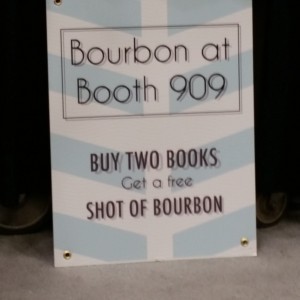
I’ve used this tactic myself, but my method was ‘Buy One Book and get Two Shots.’ And you had to drink the shots before you read the book…
The convention registration process was impressive. The layout of the registration area and kiosks provided plenty of stations for people to register. Each kiosk held at least four computers and a printer for printing your conference badge. An assistant attended each kiosk, reminding me of the ‘self-checkout’ at some stores. I asked if they had experienced any long lines, and they said there was a line when they first opened, but that went fairly quickly and there really hasn’t been a line since. Well done.
The programming was impressive. Literally hundreds of panels spanned the 4-day conference, covering many different aspects of writing fiction. (Well, Most fiction anyway. See below.) I attended panels on historical accuracy, the crossover of writing and musicianship, and the evolving relationships between traditional publisher-editors and their authors (sans agent.) All of the presentations were of 3000 to 5000 college level caliber.
It took me a moment to process the event list when I got to “Lactation Room.” Ugh. Why would anyone want to talk about that, amiright? The next listing was “Quiet Room” and then it all made sense. I wish there’d been a “Phelm Room” because I’m still dealing with congestion from my bout with pneumonia not long ago. Anyway, what I’m trying to say is there was a lot of thought put into this event.
For example, check out the #AWP15 Tweet Sheet. It’s a guideline for using Twitter at the conference. QED.
The bookfair was vast. It took close to an hour just to wander the aisles of the bookfair, and that was without interacting with the vendors. There were tons of college presses present, and indie publishers. A healthy dose of indie-author support services, and even some startup software companies to help either teach writing courses or otherwise make your writing better. I met some great local resources that I’ll pass along in future blog posts…
But first, let me point out some areas that could use some improvement.
The Meh

Poetry is better in 3D. And with a soundtrack. Broadsided Press http://www.broadsidedpress.org/
Registering online before the event required a membership. Ick. Instead, I showed up at the door with $40 and a winning smile. Sadly, the registration process required me to create an account and membership with AWP anyway. Had I known that, I would have registered online. Grr. I suspect this has to do with the AWP’s grant eligibility a’la the National Endowment for the Arts. In which case, the more members they have, the better their funding. Fine, I suppose. But I personally don’t want be a “member” of every business I do business with. Disappointing, when you are already paying premium pricing to attend. And I’ll be more disappointed when they start spamming me to renew my membership.
The program scheduling was… strange. The programming ran until 5:45PM, with a break around noon for lunch. But the bookfair closed at 5PM (and some people started packing up around 3:30). Which means if you managed to fill your day with non-stop programming, you would miss the bookfair. So in order to fit the bookfair into your schedule, you may have to miss out on lunch or some programming. This scheduling problem is compounded when you are running on a Saturday Only pass, so I suppose this could be avoided with a weekend pass. But couldn’t they have scheduled a larger break in the programming, or let the bookfair run longer into the evening?
Speaking of breaks in the programming, there was a large opening between 6PM at the end of the programming and the “open bar’ at 10PM. (You read correctly. “Open Bar” as in free alcoholic beverages, ie: author kryptonite.) The “AWP Public Reception & Dance Party” was held at the Hilton on South Marquette FOUR HOURS after everything else shut down. As I said, the city of Minneapolis took advantage of this lull and held all kinds of events to draw con attendees (and their wallets) out into the city proper.
So, do I carouse downtown from 6 till 10? Or do I go home and come back? Sleep in my car? Trick question, because if you are parking anywhere near the convention center, you are paying to park. Yet another case where “there is no free beer.” The correct answer is – I stopped at the liquor store on the way home and came out money ahead.
But all of the above were very minor issues, and nothing that wouldn’t keep me from attending the AWP Conference if it ever returned to Minneapolis. It was definitely worth the $40 day pass. However, one thing really stood out and really bothered me.
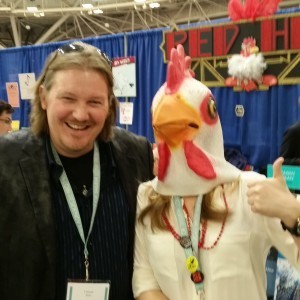
Chickens Have Thumbs! Conrad Zero gets the Chicken Thumb Of Approval from Red Hen Press http://redhen.org/
Literary Fiction vs That Other Type Of Fiction That We Just Don’t Ever Mention. Ever.
Here are the types of art recognized, reviewed, sold and discussed at the AWP Conference:
Poetry
Book and paper arts.
More Poetry
College presses teeming with contemporary fiction and memoirs…
…and even more Poetry
Literary Reviews
Books of Poems
Books on how to improve your writing
Oh yes, and there was also an overabundance of Poetry.
But genre fiction essentially did not exist. I was disappointed at the absence of genre (aka “speculative”) fiction: horror, fantasy, science fiction, weird, etc… Disappointed, but not surprised. I knew this would be the case before I attended, as it’s a well-known stigma within the industry. To this day, I don’t understand why genre fiction is treated by the Literati as… well, it actually isn’t treated. Like I said, they just don’t talk about it. The emphasis was clearly on the ‘literary’ both in the discussion panels and the book fair.
Let’s have a look at that self-description again:
AWP provides support, advocacy, resources, and community to nearly 50,000 writers, 500 college and university creative writing programs, and 130 writers’ conferences and centers. Our mission is to foster literary achievement, advance the art of writing as essential to a good education, and serve the makers, teachers, students, and readers of contemporary writing.
At first glance, it looks like there is plenty of overlap with genre fiction. I don’t know of a genre author who is against “literary achievement” or “advancing the art of writing.” But that pesky “contemporary writing” clause implies writing that is true as possible to the time period in which it is written. In other words, they want writing that captures the really-real world. Made-up characters and conflicts that never existed are fine. Stories can take place in geographies and time periods where we know they never did, as long as your fashion and technology are accurate to the geography/time. But made-up-stuff like vampires, werewolves, aliens and monsters are right out?
Someone’s gonna need to explain to me how poetry is OK, but urban fantasy is not.
One last observation. 13,000 people came to this conference. Just imagine how many people would attend if they stopped discriminating against genre fiction? What would happen if they admitted to themselves that genre fiction is every bit as much “writing” as poetry and memoirs? OK, I’m done complaining.
Summary
Despite some minor issues, the AWP Conference was a win for me. I attended some great panels, met some great people, found out about some cool services at the bookfair, and caught up with fellow authors Michael Merriam, Abra Staffin-Wiebe and Catherine Lundoff. I definitely got my $40 worth for the Saturday Only pass.
I won’t be following the conference to San Francisco next year, but if it ever stops by Minneapolis again, I’ll be sure to go. If you’re an author who wants to improve your literary-ness, (or buy some poetry) you should definitely attend this conference.
The post Reflections on AWP 2015 appeared first on Conrad Zero.
December 24, 2014
(Never Slept With) Diablo Cody
In 2008, a coworker brought me a copy of the local newspaper and pointed to the cover story. Diablo Cody had just won the Oscar for Best Original Screenplay for Juno. In the article, she said how she wrote most of the screenplay at a Starbucks in Crystal MN.
“Isn’t that right by your house?” my coworker asked.
It was. Not only was it right by my house, and not only had I been there many times, but I had actually seen Diablo Cody there many times. But I had no idea who she was until that very moment, when I saw her picture on the front page, and connected the name with the face.
“So did you ever talk to her?”
I laughed. “I saw her there a lot, but I didn’t sleep with her.”
The Song Soon To Be Formerly Known As Diablo
2008 was “The Year of the Spiral” and Jagged Spiral was at the height of its career. We were working on a jam with the temporary title of “Disco Spiral.” The jam had been around for a while but I hadn’t come up with any lyrics yet. That evening at practice, Colin asked me what I thought the song was about and something in my head just clicked.
“It’s about how I never slept with Diablo Cody.”
The song became known as “Diablo” and I used that concept to write some lyrics. We played the song out several times, and there’s a rough youtube video of us playing at Station 4 where I’m still trying to lock down the lyrics.
Unfortunately, the song was cursed. Every time we played Diablo, bad things would happen, usually equipment failures. While recording tracks for Diablo, a computer crash wiped out an entire evenings worth of recordings. We were loading gear into Colin’s car, and Colin said the song might be cursed, because every time we played it…. Just then, the strap on his gig bag broke and the bag holding his pedal board dropped to the concrete.
It was official. Colin and Josh demanded that we never mention the “D-word” again.
So I changed the lyrics. Muted the original lyric tracks in the recording and re-recorded the new lines. Diablo Cody became Diablo the Devil. I added some angels and sexual innuendos. Colin proclaimed the song was now called “Prophet” and you’ll see it listed that way on the Fire And Dice album. I’m not displeased with the new lyrics, but to be honest, I missed the original lyrics.
The Return of Diablo
Prophet was released on the Fire and Dice album in Dec 2013. In January 2014, I started to poke around the project file. Deleted the new lyrics and unmuted the original vocal tracks. Touched up a couple lines, and even managed to add in references to her more current projects, United States of Tara, Young Adult and Paradise. Replaced the drum kit with MIDI drums. Cut out a boring section of the song that we had intended to cover with solo guitar later but never did. I mixed and mastered the track and decided that I would give it to Diablo Cody as a Christmas gift.
This song is not intended as any kind of jab or insult. I have nothing but respect for Diablo Cody and hope she continues to write awesome screenplays.
I don’t know Diablo Cody, but she seems like the kind of person who would appreciate the sense of humor in this song. I hope she likes it.
Fire and Dice by Jagged Spiral
The post (Never Slept With) Diablo Cody appeared first on Conrad Zero.
October 20, 2014
Spooky Halloween Drabble – My Boss Is Evil
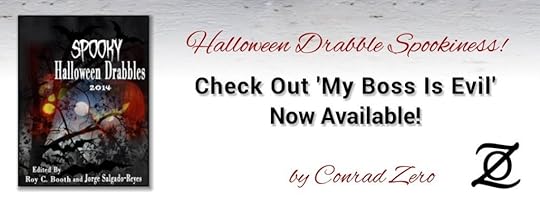 When I learned about the opportunity to write a “drabble” for a Halloween-themed drabble anthololgy, I didn’t even know what a drabble was. I had to look it up.
When I learned about the opportunity to write a “drabble” for a Halloween-themed drabble anthololgy, I didn’t even know what a drabble was. I had to look it up.
According to wikipedia, a drabble is a 100-word fiction story. Exactly one hundred words. No more. No less.
As you can imagine, I was able to write one very quickly. It was more of a challenge than I thought to get exactly one hundred words. But in an evening, I’d written a spooky little drabble about someone having a bad day at the evil office performing evil tasks for their evil boss.
My drabble titled My Boss Is Evil was accepted for publication in the Spooky Halloween Drabbles 2014 anthology, and it is now available for just 99 cents on amazon.com:
Spooky Halloween Drabbles 2014
Warning! Drabbles are higly addictive! Each one just takes a few seconds to read, and once you start in on these spooky little fiction snacks, it’s like opening a tube of Girl Scout Thin Mint Cookies. It’s tough to stop!
The post Spooky Halloween Drabble – My Boss Is Evil appeared first on Conrad Zero.
October 14, 2014
Free $15 iTunes Gift Card! – Check out The Devil’s Hand #DevilsHand
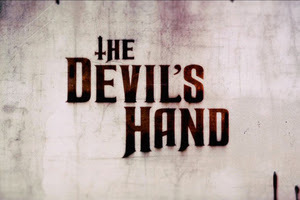 Thinking about having a creepy Halloween get-together? Download The Devil’s Hand and throw a #ProphecyParty as well. Download the free Prophecy Party instructions, invite 5 friends over and follow the instructions to see who will survive!
Thinking about having a creepy Halloween get-together? Download The Devil’s Hand and throw a #ProphecyParty as well. Download the free Prophecy Party instructions, invite 5 friends over and follow the instructions to see who will survive!
When six girls are born on the sixth day of the sixth month to different mothers in the small, devout village of New Bethlehem an ancient prophecy is set in motion – on their 18th birthday one of the girls will become the Devil’s Hand. As the day approaches and one by one the young women begin to disappear, terror overtakes the quiet community and those remaining girls band together to uncover who or what is behind these treacherous acts.
The Devil’s Hand is now available on iTunes, VOD and in select theaters. Starring Jennifer Carpenter (Dexter), Rufus Sewell (Dark City), and Adelaide Kane (The CW’s Reign).
Download The Devil’s Hand on iTunes here – http://bit.ly/THD_iTunes
Download The Prophecy Party Player’s Guide here – http://bit.ly/THDPP
And if that wasn’t enough Halloween fun, Roadside Attractions has provided me with a $15 iTunes gift card for one lucky fan of conradzero.com!
How to Win a Free $15 iTunes Gift Card!
If you’re already a member of The Cult of Zero, then you’re already entered in the drawing! If not, then simply join the Cult of Zero mailing list using the form below, and you’ll be automatically be entered for a chance to win the $15 iTunes gift card.
On Wednesday October 22, I’ll select one lucky member from the Cult of Zero as the winner!
The Devil’s Hand Blog App
Legal Stuff
Prize is provided by Roadside Attractions.
The prize will be sent via FedEx or USPS. No P.O. Boxes!
Each household is only eligible to win One (1) $15 iTunes Giftcard via blog reviews and giveaways. Only one entrant per mailing address per giveaway. If you have won the same prize on another blog, you will not be eligible to win it again. Winner is subject to eligibility verification.
On the due date, one member of the Cult of Zero mailing list will be selected at random and contacted by email. They’ll have 24 hours to respond with their mailing address. If the winner does not respond within 24 hours, or cannot provide a mailing address meeting the requirements above, I’ll select another winner.
The post Free $15 iTunes Gift Card! – Check out The Devil’s Hand #DevilsHand appeared first on Conrad Zero.


